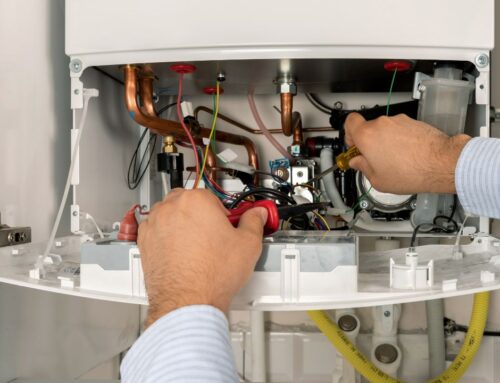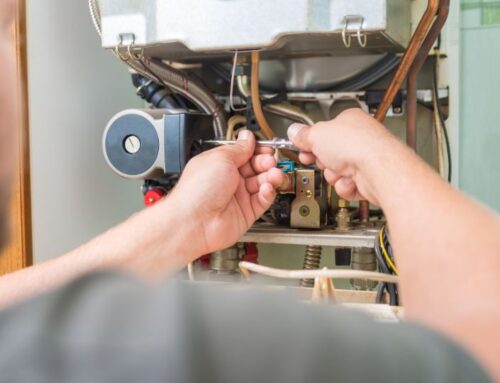Five Things to Consider Before Water Heater Installation
A new water heater is more than just an upgrade. This is an investment in improving the efficiency and safety of your home. To ensure that your choice not only fulfills your daily needs but also aligns with your long-term financial and safety goals, it is essential to take into account five key factors.
From finding the perfect size to understanding energy efficiency ratings and following local codes, every detail is important. Opting for professional installation can prevent future issues, and responsibly disposing of your old unit reflects a considerate, eco-friendly decision. Let’s explore these considerations together to ensure a smooth transition to your new water heating system.
1. Determine the Right Size and Type
Selecting the right size and type of water heater is crucial to ensure your household enjoys a sufficient supply of hot water while prioritizing safety and energy efficiency.
Why Size Matters
Choosing the correct size prevents safety issues and ensures comfort. A too-small water heater may struggle to meet your household’s hot water needs, causing shortages during peak times. On the other hand, an oversized unit consumes excess energy, leading to higher bills and potential safety risks from excessive heat. Experts recommend sizing based on household size and peak hot water demand.
Types of Water Heaters
There are two main types: tankless (on-demand) and conventional storage (with a tank).
- Tankless Water Heaters: These heat water instantly without a storage tank, offering energy efficiency by eliminating standby heat loss. However, they may have limitations when multiple hot water outlets are in use.
- Conventional Storage Water Heaters: These store hot water for immediate use, providing a steady supply. While more affordable upfront, they may be less energy-efficient due to standby heat loss.
Choosing the Right Type
Consider these factors when deciding between tankless and conventional storage water heaters:
- Fuel Type: The energy source (electricity, gas, or solar) affects operation costs, size, and energy efficiency.
- Household Size and Usage: The number of people and hot water usage patterns determine the right size and type.
- Space: Ensure sufficient space for installation, especially for larger conventional storage units.
- Installation Requirements: Tankless models may need plumbing adjustments or upgrades to electric or gas lines.
Experts recommend consulting a qualified contractor or plumber to find the best water heater for your needs. Taking all factors into account ensures optimal performance and efficiency, enhancing your overall hot water experience.
2. Energy Efficiency Considerations
Prioritizing energy efficiency in water heaters is crucial for achieving long-term cost savings, given that these devices contribute to approximately 20% of a home’s overall energy consumption. Investing in an energy-efficient water heater can translate into substantial reductions in utility bills.
Key Recommendations for Enhanced Energy Efficiency:
- Energy Efficiency Rating (UEF): Experts advise assessing a water heater’s efficiency through the Uniform Energy Factor (UEF). This metric gauges the amount of hot water produced per unit of fuel consumed over a typical day. A higher UEF signifies a more efficient water heater.
- Energy Star Certification: Water heaters bearing the ENERGY STAR label undergo independent certification for energy efficiency. For example, an ENERGY STAR-certified heat pump water heater can save a four-person household around $470 annually on electric bills, compared to a standard electric water heater, and accrue over $4,500 in savings throughout its lifetime.
- Type of Water Heater: Consider energy-efficient options like heat pump water heaters (hybrid) that can be up to three times more efficient than conventional electric models. Similarly, tankless water heaters (on-demand) only heat water when in use, reducing overall energy consumption.
Understanding the Impact of Fuel Type:
The choice of fuel type significantly influences not only the water heater’s annual operation costs but also its size and energy efficiency. For instance, gas water heaters tend to be more cost-effective to operate compared to their electric counterparts. While solar water heaters involve higher upfront costs, their reliance on free solar energy can lead to substantial long-term savings.
3. Compliance with Local Codes and Safety Standards
It’s important to follow local building and plumbing codes when installing a new water heater to make sure it’s safe and legal. These codes, crafted by industry experts and officials, aim to establish structures that are secure, efficient, and dependable. They oversee the design, installation, and inspection of plumbing systems, including water heaters, to prevent potential hazards such as fires, chemical leaks, or sanitation problems.
Why Adhering to Local Codes Matters
Local codes vary between states, counties, cities, and even individual communities, and they can change regularly. Sticking to these codes is vital to avoid fines and guarantee that the water heater installation meets the required standards for safe operation. It’s advisable to reach out to local city or county departments for details on permits and the current building codes in your area.
Safety Standards for Water Heater Installation
Experienced plumbers stress the importance of maintaining a safe environment around the water heater. This involves keeping combustible materials at least 18 inches away from the unit to prevent fire hazards. Setting the correct water heater temperature is also crucial to prevent scalding. The recommended safety setting is 120 degrees Fahrenheit—protecting against scalding while also preventing bacteria growth.
Advice from Seasoned Plumbers:
Experienced plumbers strongly advise against homeowners attempting to install water heaters themselves due to the complexity of adhering to codes and the potential risks involved. Instead, hiring a licensed professional ensures that the installation meets all safety standards and code requirements, also safeguarding the warranty of the water heater. Proper installation includes ensuring the water heater has adequate space for ventilation and that no items obstruct the view, allowing for early detection of leaks or other issues.
4. Professional Installation and Maintenance
Opting for a licensed professional when installing a water heater is strongly recommended due to the intricate nature of the task and the potential risks involved. A professional ensures that the installation aligns with safety standards and code requirements, thereby safeguarding the warranty of the water heater.
Benefits of Professional Installation:
- Expertise and Compliance: Professional plumbers possess the knowledge and experience to adhere to local building codes and regulations, ensuring a safe and legal installation.
- Access to Quality Equipment: Professionals have access to top-tier brands and models, some exclusive to installers, not available in retail stores.
- Permit Handling: Professionals manage the permit process required for water heater installation, streamlining the administrative aspects.
- Correct and Safe Installation: Professionals install the water heater correctly and safely the first time, saving time and potential hassles.
- Troubleshooting: Professionals can identify and address issues with your current heater, potentially saving you from unnecessary replacements.
Importance of Regular Maintenance:
Regular maintenance is crucial for the longevity, safety, and efficiency of your water heater. This includes:
- Inspecting and Replacing Anode Rods: Prevents tank corrosion by replacing deteriorating rods.
- Flushing the Tank: Eliminates sediment buildup for efficient operation.
- Testing Safety Relief Valves: Prevents catastrophic failures by releasing excess pressure and temperature buildup.
Installation Checklist:
Follow this checklist for proper water heater installation:
- Drain the old water heater.
- Shut off the gas and remove the flue (if applicable).
- Disconnect the gas line (if applicable).
- Separate the old tank from the water lines.
- Install the new water heater in an approved location with proper ventilation.
- Place a sediment trap on the gas line into the unit.
- Connect water lines to the new water heater.
- Connect the gas line (if applicable).
- Install the flue (if applicable).
- Fill the tank and check for leaks.
- Light the pilot and turn on the new water heater (if applicable).
Remember to test safety relief valves once or twice yearly to ensure proper functionality.
5. Disposal of the Old Water Heater
Properly disposing of the old water heater is a crucial aspect of the installation process, extending beyond making space for the new unit. It involves environmental responsibility and adherence to local disposal regulations.
Significance of Proper Disposal:
Old water heaters, especially non-functioning ones, should not be casually left for regular trash service. Many components, including metals and occasionally hazardous materials, can be recycled or require special handling. Improper disposal poses environmental risks and may violate local waste disposal regulations.
Recommendations from Experienced Plumbers:
Experienced plumbers often include the removal of the old water heater as part of their installation service. They are well-versed in local regulations and equipped to handle the heavy and sometimes awkwardly shaped tanks.
Additional Costs and Logistics:
When preparing for new water heater installation, consider potential costs and logistics:
- Removal Fee: Some plumbers or installation companies may charge an extra fee for old water heater removal.
- Transportation: Transporting the old unit to a recycling center or disposal facility may incur a cost.
- Recycling Fee: Recycling services might charge a fee for processing the water heater.
- Permits: Some areas may require permits for the disposal of large appliances like water heaters.
Disposal Options:
- Recycling Programs: Many areas have recycling programs accepting old water heaters, and reclaiming metals and materials for reuse.
- Municipal Pick-Up: Local waste management services may offer pick-up for large appliances, often for a fee.
- Scrap Yards: Taking the old water heater to a scrap yard could result in payment for the metal.
- Professional Removal: Plumbers can handle disposal, ensuring it’s done safely and in compliance with the law.
Proper disposal is not just a practical necessity but a commitment to environmental stewardship, contributing to sustainable waste management practices.
Conclusion
Installing a new water heater is a significant undertaking that requires thoughtful consideration of numerous factors. These considerations include choosing the appropriate size and type of water heater, ensuring energy efficiency, adhering to local codes and safety standards, selecting a professional installer and regular maintenance, and ensuring that the old water heater is disposed of responsibly.
In addressing these aspects attentively, you can ensure a safe, efficient, and cost-effective water heater installation. Whenever possible, you should consult with a licensed professional to ensure the best results for your home’s hot water needs.



